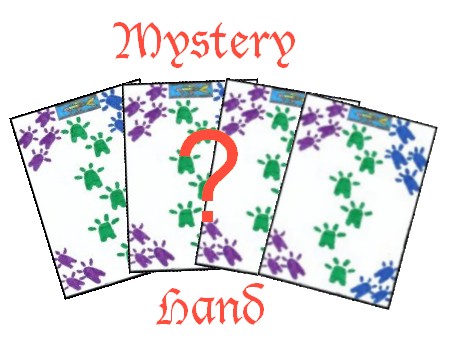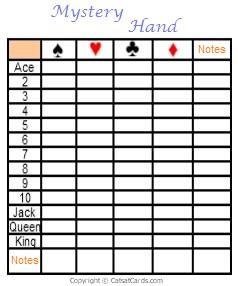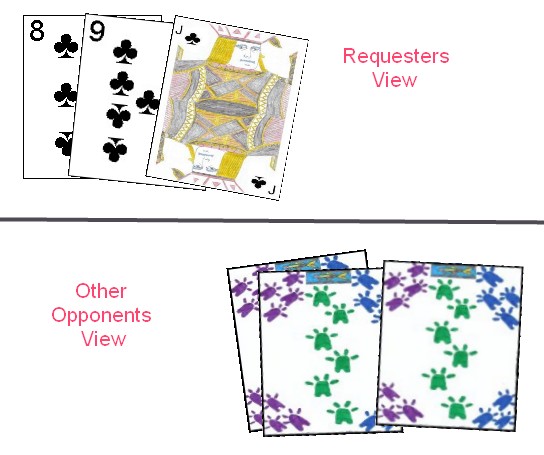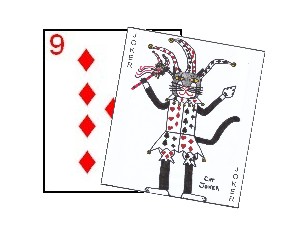
Mystery Hand is a unique and fun game created by the Cats themselves and exclusively found here at Cats at Cards.
Mystery hand can be played by 3 to 8 people and is at its best with 4 or 5. See the variations section below for a great version especially designed for two players. This game is played with the standard 52 card deck, consisting of four cards of each denomination Ace through King, one in each suit. Although in general the cards have no specific ranking in this game, there are circumstances where a player may specify a request (see below) for a series or run of cards. Thus, for the purpose of these runs, the standard deck ranking is used, as follows (high to low): Ace, King, Queen, Jack, 10, 9, 8, 7, 6, 5, 4, 3, 2, Ace. Notice that the Ace can fall at the beginning or end of such a series, to be specified by the requester.
The first dealer can be determined in any manner, usually by having all participants cut for high card with the player receiving this high card having the right to be the first dealer. In the case of a tie for high card, the identically ranked cards could be further ranked by suit. In this case, the suit ranking is Spades, Hearts, Diamonds, Clubs, from high to low.
Once the first dealer is thusly determined, he should first shuffle the cards and then offer them to the player to his right for cutting.
 |
| Each Player should be provided with a Mystery Hand memory sheet which they can use to mark off cards they discover cannot be in the mystery hand. Click here for printable versions that can be used for your own games of Mystery Hand. |
|
After the cut, the dealer begins by dealing four cards, face down to the center of the table. Special card should be taken to ensure no player (including the dealer) is able to see the faces of these cards so their identity is strictly unknown to all participants in the game. Once these four cards are dealt, they should be squared up in a small stack in the center of the table.
Before dealing the cards each player should be given a pad of paper or
other marking mechanism as well as a pencil for the purpose of recording the results of the various card requests made to and by other players. This pad should contain a grid with a space or mark for every card in a normal deck. Special memory sheets can be quickly created by the players or they can print the one shown to the right, which is ready for immediate use. Click this
link for a printable version of the memory sheet. As the players discover, through play of the game, cards or potential cards in other players hands they can make appropriate marks on the pad. These pads should be retained and held by the players in such a way so that other players are not able to view them, as doing so another player may be able to gain an unfair and significant advantage in the game.
The dealer then takes the remainder of the pack and begins dealing one card to each player, clockwise around the table, starting with the player to his immediate left.
The dealer continues dealing around the table, one card per revolution as far as the cards will deal evenly (such that each player will receive the same number of cards). The cards are dealt face down in front of each player. The number received will be dependant on the number of players in the game, as follows:
| Players | Cards Received |
|---|
| 3 | 16 |
| 4 | 12 |
| 5 | 9 |
| 6 | 8 |
| 7 | 6 |
| 8 | 6 |
|
|
|
Any odd cards which would not allow the deck to be dealt out evenly amongst the players are then dealt face up to the center of the table where they can be viewed by all. This is not an issue for 2, 3, 4, 6 and 8 players as the cards will deal out evenly. However, for 5 players there will be 3 face up cards dealt to the center and with 7 players there will be 6 face up cards dealt to the center.
The object of this game is to attempt to correctly identify the exact contents of the four card mystery hand which has been dealt to the center of the table. The players attempt to do this through information requests to other players during his turn. In addition, valuable information can be gathered by carefully watching carefully what cards other players request and the results of those requests.
After the cards have been dealt each player then examines his hand and marks his sheet corresponding with the cards in his hand.
Play then begins with the player to the dealers immediate left who makes the first request. On a players turn, he may make any one of a number of requests in an attempt to determine what cards are in the other players hands, which in turn will help him determine what specific cards are in the Mystery Hand. On his turn, a player may do any of the following:
- Specific Player Request: When a player uses this request he asks any other player at the table for a specific hand. The player indicates the player he wants to question and may ask for one of the following specific four card hands:
- Suited Run: The player asks for a specific four card suited run, naming both the suit and the top and bottom cards in the run. All the cards requested must be in sequential order and of the same suit. For instance, the player could say, "Bill, do you have a suited run in Diamonds from four to seven?"
For ordering purposes of these straights, an ace can be part of the high straight (J, Q, K, A) or the low straight (A, 2, 3, 4).
- Four of a Kind: The player asks for a specific set of four identically ranked cards. For instance, the player may ask "Jane, show me all of your 5's."
 |
| While the requester will have the opportunity to see the faces of the requested cards, the other opponents will only be allowed to see the number of cards displayed (the card backs). |
If the player asked has one or more of the requested cards, he must show these cards to the requester in such a way that the requester can see the card faces, but the other players only see the card backs. The other players must be given the opportunity to see the number of cards displayed, which may help them to eliminate (by process of elimination) cards from their sheet that cannot be contained in the mystery hand. The requester would then presumably mark these cards on his sheet to help him remember they are in play and cannot be contained in the mystery hand. A player can never ask for a set of cards in which he holds, in his own hand, all four of the cards requested. If, after a request, three or four of the requested cards are held by the requestee, after the display, the requester is entitled to an additional turn. In this turn he can make another, different request from the same or any other player. If the requestee has no cards that fall into the range of the request, they would simply state this and show no cards.
- Request From All: This request is similar to the Specific Player request above. However, when making this request the requester does not specify an individual player but rather makes a general request of all other players at the table. However, instead of a player showing the requester the identities of the cards, they simply place all cards from their hand that meet the requested criteria face down in front of them such that the requester and all other players can see how many such cards they player held. Any player (except of course the requester) must place any cards meeting the requested criteria in front of him.
The requester can indicate this type of request by stating "Everyone, I am trying to find the following hand". Similar to the specific player request, the player may ask for either a specific four card suited run or a specific four of a kind. A player may never make a request in which he holds all of the cards requested. If all four cards are revealed for this request, the requester may take another turn in which he can make any valid request.
- Exact Card: When a player specifies this type of request they are making a request for one specific card. They do not specify any individual player, but rather just ask for a card by rank and suit (for instance he may state "I am trying to find the King of Spades"). Whomever has the requested card must then display it such that the requester and all the other players can view it. He then adds the card back into his hand. The requester and the players can then mark their cards accordingly. If no player has the card, they can also use this information to great affect (knowing that card must be in the mystery hand). A player may never make a request for an individual card that he holds in his hand.
- Declaration: A player, when he believes he knows the exact identity of the concealed mystery hand may make a declaration. The player states the exact four cards (by suit and rank) that they believe to be in the mystery hand. Upon making this declaration, the declaring player picks up the mystery hand (such that his opponents cannot see the faces) and verifies if the hand is as stated. If the mystery hand is, in fact exactly as stated, he immediately displays it to the center of the for all to see. This player is then declared the winner. However, if the card is not as stated the declarer must replace the mystery hand face down on the table. He must then place his own hand, spread out, face up on the table. The other players can then attempt to make best use of the cards in the hand. He must drop from the game, with the hand continuing with the next player in turn.
The first player to correctly identify the exact cards contained in the mystery hand is the winner of the hand. However, if a player makes an incorrect declaration, and there is only one other remaining, active player in the hand, that remaining player instantly wins the hand.
The winner of each hand would then deal the next hand (after the standard shuffling and cutting procedures).
There are several variations of Mystery Hand that are sometimes played that dramatically change the dynamics of the game.
No Memory Sheet: This variation is played identically to the standard version with one very important difference which can make this a very challenging variation. The players are not provided paper or memory sheets to notate or otherwise help remind themselves what cards they may have already discovered the whereabouts of. The players should not use any type of aid in helping to memorize the cards have they seen and the cards potentially in the mystery hand. This can be a very challenging version of this game as players must rely on their memory (and their own cards) to help them win the game.
The Sneak: In this version, after the four card mystery hand is dealt to the center of the table, two jokers are shuffled in with the remainder of the deck. This deck is then dealt to the players as normal. Because there are two additional cards added to the deck, the number of cards dealt to each player may be slightly different from the parent game:
|
|
|
| Players | Cards Received |
|---|
| 3 | 16 |
| 4 | 12 |
| 5 | 10 |
| 6 | 8 |
| 7 | 7 |
| 8 | 6 |
|
When this variation is played by 5 players the cards will divide out evenly. However, with 3, 4, 6 and 8 players there will be two extra cards dealt face up to the center of the table and with 7 players, there will be 1 card dealt face up to the center. Because of the method in which the Jokers are used, their addition would have no affect when played by two.
 |
| Adding the sneak to the cards displayed can add confusion and uncertainty to some of the opponents. |
When a request is made of a particular player, he may include the Joker (called The Sneak) as one of the cards displayed to the requester. This would normally be done in an effort to keep other players from being certain of what cards might be displayed. The regular rule of a player receiving another play is still in affect (whether the cards displayed contain the Sneak or solely consist of other cards). If the same player happens to have both Jokers he could add both to the cards displayed to an opponents request. A player need not have any of the actual cards requested when showing the sneak, but if he does have any of the cards actually requested, those must be also be displayed to the requester.
Other than these differences, the remainder of the game is identical to the standard version.
Keep em Guessing: In the standard version of this game described above, a player may never ask for a specific card or group of cards in which he holds all the requested cards. However in this version this restriction is relaxed.
This results in two changes to the requests a player can make which a player may use to confound his opponents.
First, when a player is asking for a specific card request, he may ask for a card that he does have in his hand. This might be done to cause other players to assume the asked for card was contained in the mystery hand.
Secondly, when a player makes a request to a specific player for a particular set or run of cards, he could ask for cards that he actually already has in his hand. Again, this might be done in an attempt to cause the other players to make inaccurate assumptions about the cards found in the mystery hand.
No Exact Card Requests: Mystery Hand is sometimes played in a variation in which the Exact Card request type is removed. A player may never make a request for one specific card from all players. A player, on his turn, may make any of the other valid request types.
Mystery Hand For Two: Although the standard version of Mystery Hand can be played by two, there is a version especially for two players. In this version, both players are first dealt a four card mystery hand in the normal manner. These hands are dealt out face down in front of each player. The players would then look at this hand (concealed from the other player) and specially notate the cards on their memory sheet. Once both players have done this, these hands are moved to the side, still in front of each player. After this, these hands should not be touched or viewed by the player until the end of the game.
After these hands are set aside, the dealer than would deal out the remainder of the deck face down to each player, one by one. Each player will receive 48 cards. Once the deck is fully dealt, the players would then examine their hands and notate their memory sheet as appropriate. Once complete, the non-dealer then makes the first play. Just as in the standard version, he would then make a request of the other player (in the normal manner). On his turn a player may make a request from the other player of a suited run or a four of a kind. In the two player version however, a player is never provided a second consecutive turn, no matter how many cards his opponent must expose to him based on his request. Since there are only two players, any cards exposed by either player can be displayed temporarily face up to the center of the table upon a request. In addition to the suited run and four of a kind, when a player believes he knows the exact composition of the mystery hand he may use his turn to make a declaration. When doing so, the player states the exact cards he believes will be found in the mystery hand by suit and rank. After doing so, the declarer exposes his opponents mystery hand. If he is correct about the exact card of the mystery hand he wins the hand. If even one of the cards is incorrect, however, his opponent is declared the winner of the hand.
A slight variation of the two player version is to deal out the entire deck out between the two players in the normal manner. After each player examines his hand, he selects four cards and sets them aside face down to create his mystery hand. Once set aside, the player may not look at or touch his mystery hand in any manner. The game then proceeds as in the normal two player version of Mystery Hand.
Another variation of the two player version of Mystery Hand can also be played. In this version, neither player views the contents or their own mystery hand either and simply places it face down in front of himself. Play continues as in the standard two handed version with the understanding that the identity of 10 cards are never seen by either player until a player is ready to make their declaration on their turn. On a players turn, when he is ready to make his declaration, will indicate this by turning his own Mystery Hand face up. He can then use the information from the cards displayed and his own observations through the game to make his declaration on what he thinks the opponents mystery hand contains. If he is correct he is immediately declared the winner, however, if he is incorrect the opponent wins the hand.
Copyright © 2015
CatsAtCards.com. All rights reserved.
 Mystery Hand is a unique and fun game created by the Cats themselves and exclusively found here at Cats at Cards.
Mystery Hand is a unique and fun game created by the Cats themselves and exclusively found here at Cats at Cards.

